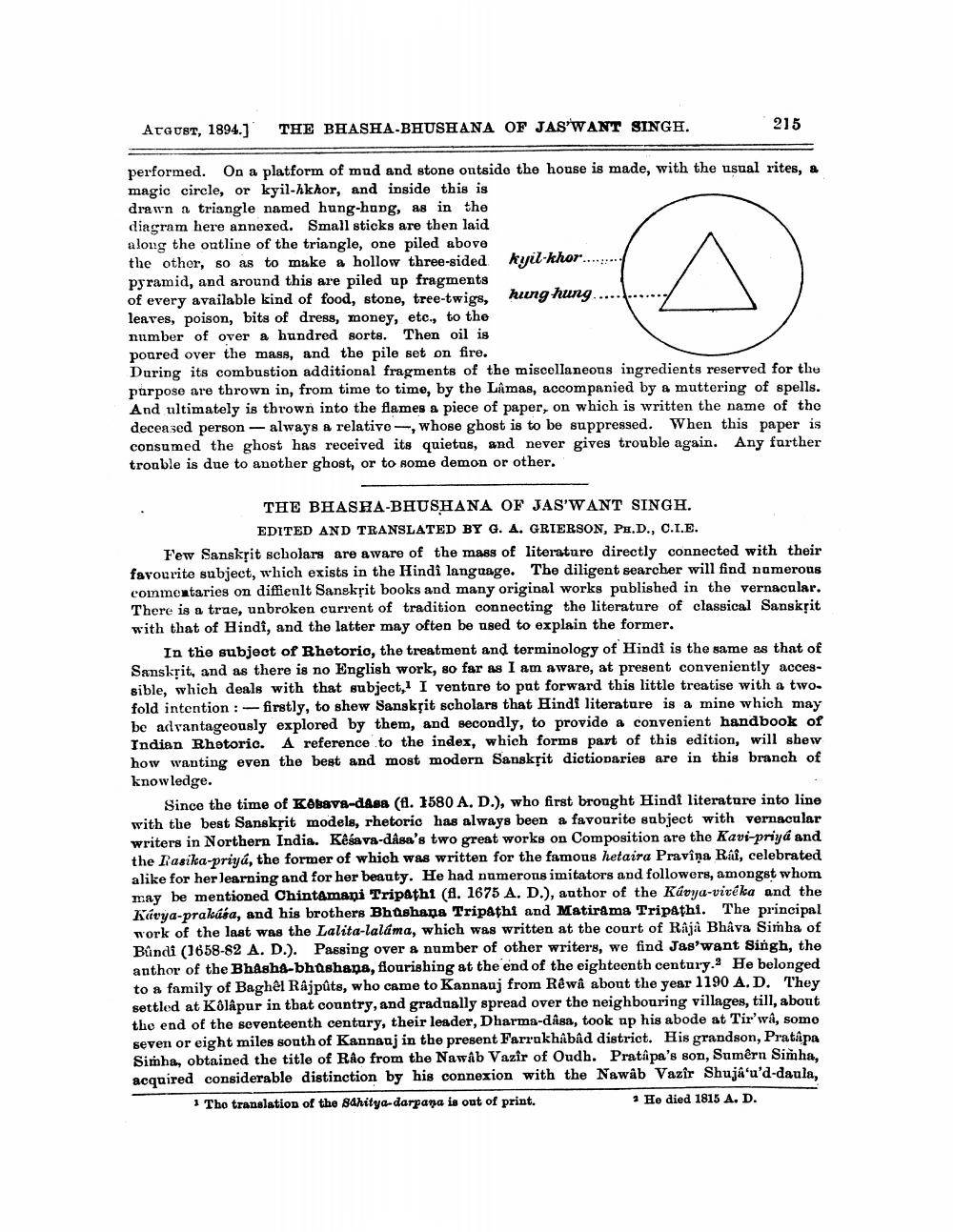________________
Araust, 1894.]
THE BHASHA-BHUSHANA OF JAS'WANT SINGH.
215
performed. On a platform of mud and stone ontside the house is made, with the usual rites, & magic circle, or kyil-hkhor, and inside this is drawn a triangle named hung-hong, as in the diagram here annexed. Small sticks are then laid along the ontline of the triangle, one piled above the other, so as to make a hollow three-sided kyil-khor...... pyramid, and around this are piled up fragments of every available kind of food, stone, tree-twigs, hung hung..... leaves, poison, bits of dress, money, etc., to the number of over a hundred sorts. Then oil is poured over the mass, and the pile set on fire. During its combustion additional fragments of the miscellaneous ingredients reserved for the purpose are thrown in, from time to time, by the Lamas, accompanied by & muttering of spells. And ultimately is thrown into the flames a piece of paper, on which is written the name of the deceased person - always a relative , whose ghost is to be suppressed. When this paper is consumed the ghost has received its quietus, and never gives trouble again. Any further tronble is due to another ghost, or to some demon or other.
THE BHASHA-BHUSHANA OF JAS'WANT SINGH.
EDITED AND TRANSLATED BY G. A. GRIERSON, PH.D., C.L.E. Few Sanskrit scholars are aware of the mass of literature directly connected with their favourite subject, which exists in the Hindi language. The diligent searcher will find namerous commentaries on diffienlt Sanskrit books and many original works published in the vernacular. There is a true, unbroken current of tradition connecting the literature of classical Sanskrit with that of Hindi, and the latter may often be used to explain the former,
In the subject of Rhotorio, the treatment and terminology of Hindi is the same as that of Sansksit, and as there is no English work, so far as I am aware, at present conveniently accessible, which deals with that subject, I ventare to put forward this little treatise with a twofold intention :- firstly, to shew Sanskrit scholars that Hindi literature is a mine which may be advantageously explored by them, and secondly, to provide a convenient handbook of Indian Rhetoric. A reference to the index, which forms part of this edition, will shew how wanting even the best and most modern Sanskrit dictionaries are in this branch of knowledge.
Since the time of Kokava-dAsa (A. 1580 A, D.), who first bronght Hindi literature into line with the best Sanskrit models, rhetoric has always been a favourite subject with vernacular writers in Northern India. Kêśava-dasa's two great works on Composition are the Kavi-priya and the lasika-priya, the former of which was written for the famous hetaira Pravîna Rai, celebrated alike for her learning and for her beauty. He had numerous imitators and followers, amongst whom may be mentioned Chintamani Tripathi (fl. 1675 A. D.), author of the Kavya-vitéka and the Kavya-pralcóa, and his brothers Bhtshana Tripathi and Matirama Tripathi. The principal work of the last was the Lalita-laláma, which was written at the court of Raja Bhâva Simha of Bûndi (1658-82 A. D.). Passing over a number of other writers, we find Jas'want Singh, the anthor of the Bhashs-bhashana, flourishing at the end of the eighteenth century. He belonged to a family of Baghel Rajpûts, who came to Kannauj from Rêwâ about the year 1190 A.D. They settled at Kolapur in that country, and gradually spread over the neighbouring villages, till, about the end of the seventeenth century, their leader, Dharma-dasa, took up his abode at Tir'wâ, somo seven or eight miles south of Kannauj in the present Farrukhâbâd district. His grandson, Pratâpa Simha, obtained the title of Rio from the Nawab Vazir of Oudh. Pratapa's son, Sumêrn Simha. acquired considerable distinction by his connexion with the Nawab Vazir Shuja'u'd-daula, · The translation of the Sahitya-darpana is out of print.
1 He died 1815 A. D.




